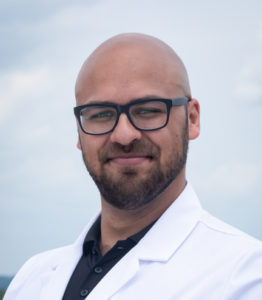Rosacea – Diagnosis, Symptoms, and Treatment

Medically reviewed by Dr. Nathan LeDeaux, MD
Updated - January 11, 2021
Nathan LeDeaux is an emergency medicine physician at the University of Wisconsin and got his M.D. from Northwestern University in Chicago Illinois.
What is Rosacea?
Rosacea is a skin condition characterized by persistent facial redness, facial flushing, dryness, and sensitivity. Individuals may also develop small dilated blood vessels (telangiectasias) on the face. The disease is most often seen in adults and rarely affects children – leading to the name “adult acne.” Rosacea is most common in fair-skinned such as those of Celtic and Northern European origin.
The precise cause of the disease is uncertain but likely related to immune system abnormalities, reactions to skin bacteria, and exposure to UV (ultraviolet) radiation. Various factors can make the condition worse, including extreme temperature, sun exposure, hot beverages, spicy foods, and alcohol.
What Causes Rosacea?
The precise cause of rosacea is not known, however, the condition appears to be related to abnormalities in the immune system and inflammatory reactions against bacteria that live on the skin. UV (ultraviolet) radiation damage from the sun is also thought to be critical in the development of rosacea. Lastly, there is evidence to suggest that vascular reactivity contributes to facial flushing in rosacea. Dilation of the blood vessels of the face typically leads to flushing and erythema (redness).
Various factors may lead to exacerbations of rosacea symptoms including:
- Extreme temperature (hot or cold)
- Ultraviolet (UV) exposure
- Hot beverages or spicy foods
- Alcohol
- Exercise
- Use of topical creams or ointments
- Mood changes such as anger and embarrassment
How Common is Rosacea?
Rosacea is relatively common, since the majority of affected individuals do not seek treatments its exact prevalence is hard to estimate. The National Rosacea Society estimates that 16 million Americans are living with the disease with anywhere from 1% to 10% of the U.S. population suffering from rosacea that would benefit from medical treatment.
While dark skinned patients may suffer from rosacea, those of Celtic and Northern European origin are at increased risk for the disease.
Rosacea is much more common in adults over the age of 30 and is more common in women compared to men. This is thought to be related to hormonal changes with age and damage to the skin that is accumulated over time with sun exposure.
Signs and Symptoms
Rosacea is divided into four subtypes depending on the appearance and distribution of the rash. The primary signs and symptoms of the condition include persistent facial redness, facial flushing, dryness, and skin sensitivity. Individuals may also develop small dilated blood vessels (telangiectasias) involving the skin of the face. In some cases, lesions can have a very similar appearance to inflammatory acne. These lesions are normally papular (bumpy), nodular, or pus containing (pustular). Individuals with ocular rosacea often have eye redness (conjunctival hyperemia), inflammation of the eyelid (blepharitis), and eye irritation.
Diagnosis
The majority of patients with rosacea are diagnosed based on symptoms and the physical appearance of the facial rash alone. An erythematous (red), dry, papular (bumpy) rash located in the midface in an adult age >30 is highly suggestive of rosacea. Blood tests, x-ray imaging, and biopsies of the skin are not required to diagnose this disorder. Biopsies may still be taken if the diagnosis is in question, this is more common if you have a history of other skin conditions or have one of the rarer variants of rosacea.
Rosacea Medication
The treatment of rosacea begins with lifestyle changes such as avoiding triggers, protection against UV rays, and proper skin care. Patients often benefit from the use of facial sun block with a sun protection factor (SPF) of 30 or greater. Alcohol-based skincare products should be avoided as they may result in skin irritation. Your doctor will often encourage you to avoid mid-day sun exposure and to wear sun-protective clothes. Some patients choose to use cosmetics such as flesh-colored facial foundation to help conceal the rash and further protect the skin from the sun.
One of the most common self-administered topical therapy for facial redness is Mirvaso (Topical Brimonidine). Your dermatologist may also recommend laser or intense pulsed light treatment. These treatments help to reduce the redness of the skin and decrease the visibility of telangiectasias. These treatments are not permanent and regular re-treatment is required.
Occasionally, you doctor may recommend one of the following topical agents which decrease inflammation in the skin and killing some of the bacteria that can lead to inflammation:
- MetroGel (Metronidazole)
- Azelex (Azelaic acid)
- Subantimicrobial doxycycline
- Soolantra (Ivermectin)
- Klaron (Sodium Sulfacetamide)
Patients that fail to improve with topical treatment frequently require oral antibiotics such as Adoxa (Tetracycline), Vibramycin (Doxycycline), or Minocin (Minocycline) for 1-3 months. Patients with refractory rosacea may benefit from Accutane (oral isotretinoin). While oral antibiotics and accutane are very well tolerated in most patients they have a higher risk of side effects compared to topical medications which is why they are only used if these treatments fail.
References:
- Crawford GH, Pelle MT, James WD. Rosacea: I. Etiology, pathogenesis, and subtype classification. J Am Acad Dermatol 2004; 51:327. - https://www.jaad.org/article/S0190-9622(04)00844-8/fulltext
- Wilkin J, Dahl M, Detmar M, et al. Standard classification of rosacea: Report of the National Rosacea Society Expert Committee on the Classification and Staging of Rosacea. J Am Acad Dermatol 2002; 46:584. - https://www.ncbi.nlm.nih.gov/pubmed/15153893
- Odom R, Dahl M, Dover J, et al. Standard management options for rosacea, part 2: options according to subtype. Cutis 2009; 84:97. - https://www.ncbi.nlm.nih.gov/pubmed/19746768
The above information is an educational aid only. It is not intended as medical advice for individual conditions or treatments. Talk to your doctor, nurse or pharmacist before following any medical regimen to see if it is safe and effective for you.

